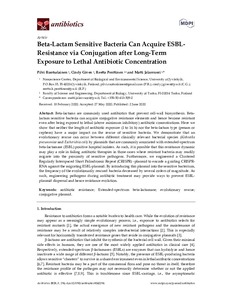Beta-Lactam Sensitive Bacteria Can Acquire ESBL-Resistance via Conjugation after Long-Term Exposure to Lethal Antibiotic Concentration
Ruotsalainen P; Given C; Penttinen R; Jalasvuori M
Beta-Lactam Sensitive Bacteria Can Acquire ESBL-Resistance via Conjugation after Long-Term Exposure to Lethal Antibiotic Concentration
Ruotsalainen P
Given C
Penttinen R
Jalasvuori M
MDPI
Julkaisun pysyvä osoite on:
https://urn.fi/URN:NBN:fi-fe2021042827151
https://urn.fi/URN:NBN:fi-fe2021042827151
Tiivistelmä
Beta-lactams are commonly used antibiotics that prevent cell-wall biosynthesis. Beta-lactam sensitive bacteria can acquire conjugative resistance elements and hence become resistant even after being exposed to lethal (above minimum inhibitory) antibiotic concentrations. Here we show that neither the length of antibiotic exposure (1 to 16 h) nor the beta-lactam type (penam or cephem) have a major impact on the rescue of sensitive bacteria. We demonstrate that an evolutionary rescue can occur between different clinically relevant bacterial species (Klebsiella pneumoniae and Escherichia coli) by plasmids that are commonly associated with extended-spectrum beta-lactamase (ESBL) positive hospital isolates. As such, it is possible that this resistance dynamic may play a role in failing antibiotic therapies in those cases where resistant bacteria may readily migrate into the proximity of sensitive pathogens. Furthermore, we engineered a Clustered Regularly Interspaced Short Palindromic Repeat (CRISPR) -plasmid to encode a guiding CRISPR-RNA against the migrating ESBL-plasmid. By introducing this plasmid into the sensitive bacterium, the frequency of the evolutionarily rescued bacteria decreased by several orders of magnitude. As such, engineering pathogens during antibiotic treatment may provide ways to prevent ESBL-plasmid dispersal and hence resistance evolution.
Kokoelmat
- Rinnakkaistallenteet [27094]
